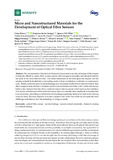Mostrar el registro sencillo del ítem
Micro and nanostructured materials for the development of optical fibre sensors
| dc.creator | Elosúa Aguado, César | es_ES |
| dc.creator | Arregui San Martín, Francisco Javier | es_ES |
| dc.creator | Del Villar, Ignacio | es_ES |
| dc.creator | Ruiz Zamarreño, Carlos | es_ES |
| dc.creator | Corres Sanz, Jesús María | es_ES |
| dc.creator | Bariáin Aisa, Cándido | es_ES |
| dc.creator | Goicoechea Fernández, Javier | es_ES |
| dc.creator | Hernáez Sáenz de Zaitigui, Miguel | es_ES |
| dc.creator | Rivero Fuente, Pedro J. | es_ES |
| dc.creator | Socorro Leránoz, Abián Bentor | es_ES |
| dc.creator | Urrutia Azcona, Aitor | es_ES |
| dc.creator | Sánchez Zábal, Pedro | es_ES |
| dc.creator | Zubiate Orzanco, Pablo | es_ES |
| dc.creator | López Torres, Diego | es_ES |
| dc.creator | Acha Morrás, Nerea de | es_ES |
| dc.creator | Ascorbe Muruzabal, Joaquín | es_ES |
| dc.creator | Ozcariz Celaya, Aritz | es_ES |
| dc.creator | Matías Maestro, Ignacio | es_ES |
| dc.date.accessioned | 2018-09-19T09:37:46Z | |
| dc.date.available | 2018-09-19T09:37:46Z | |
| dc.date.issued | 2017 | |
| dc.identifier.issn | 1424-8220 | |
| dc.identifier.uri | https://hdl.handle.net/2454/30730 | |
| dc.description.abstract | The measurement of chemical and biomedical parameters can take advantage of the features exclusively offered by optical fibre: passive nature, electromagnetic immunity and chemical stability are some of the most relevant ones. The small dimensions of the fibre generally require that the sensing material be loaded into a supporting matrix whose morphology is adjusted at a nanometric scale. Thanks to the advances in nanotechnology new deposition methods have been developed: they allow reagents from different chemical nature to be embedded into films with a thickness always below a few microns that also show a relevant aspect ratio to ensure a high transduction interface. This review reveals some of the main techniques that are currently been employed to develop this kind of sensors, describing in detail both the resulting supporting matrices as well as the sensing materials used. The main objective is to offer a general view of the state of the art to expose the main challenges and chances that this technology is facing currently. | en |
| dc.description.sponsorship | This work was supported by the Spanish State Research Agency (AEI) and European Regional Development Fund (ERDF-FEDER), TEC2016-79367-C2-2-R and TEC2016-78047-R projects. | en |
| dc.format.extent | 38 p. | |
| dc.format.mimetype | application/pdf | en |
| dc.language.iso | eng | en |
| dc.publisher | MDPI | en |
| dc.relation.ispartof | Sensors, 17, 2312 | en |
| dc.rights | © 2017 by the authors. Licensee MDPI, Basel, Switzerland. This article is an open access article distributed under the terms and conditions of the Creative Commons Attribution. | en |
| dc.rights.uri | https://creativecommons.org/licenses/by/4.0/ | |
| dc.subject | Optical fibre sensor | en |
| dc.subject | Nanotechnology | en |
| dc.subject | Nanostructured materials | en |
| dc.subject | Chemical sensing | en |
| dc.subject | Biomedical sensing | en |
| dc.title | Micro and nanostructured materials for the development of optical fibre sensors | en |
| dc.type | info:eu-repo/semantics/article | en |
| dc.type | Artículo / Artikulua | es |
| dc.contributor.department | Ingeniería Eléctrica y Electrónica | es_ES |
| dc.contributor.department | Ingeniaritza Elektrikoa eta Elektronikoa | eu |
| dc.contributor.department | Institute of Smart Cities - ISC | es_ES |
| dc.rights.accessRights | info:eu-repo/semantics/openAccess | en |
| dc.rights.accessRights | Acceso abierto / Sarbide irekia | es |
| dc.identifier.doi | 10.3390/s17102312 | |
| dc.relation.projectID | info:eu-repo/grantAgreement/ES/1PE/TEC2016-79367 | en |
| dc.relation.projectID | info:eu-repo/grantAgreement/ES/1PE/TEC2016-78047-R | en |
| dc.relation.publisherversion | https://doi.org/10.3390/s17102312 | |
| dc.type.version | info:eu-repo/semantics/publishedVersion | en |
| dc.type.version | Versión publicada / Argitaratu den bertsioa | es |



